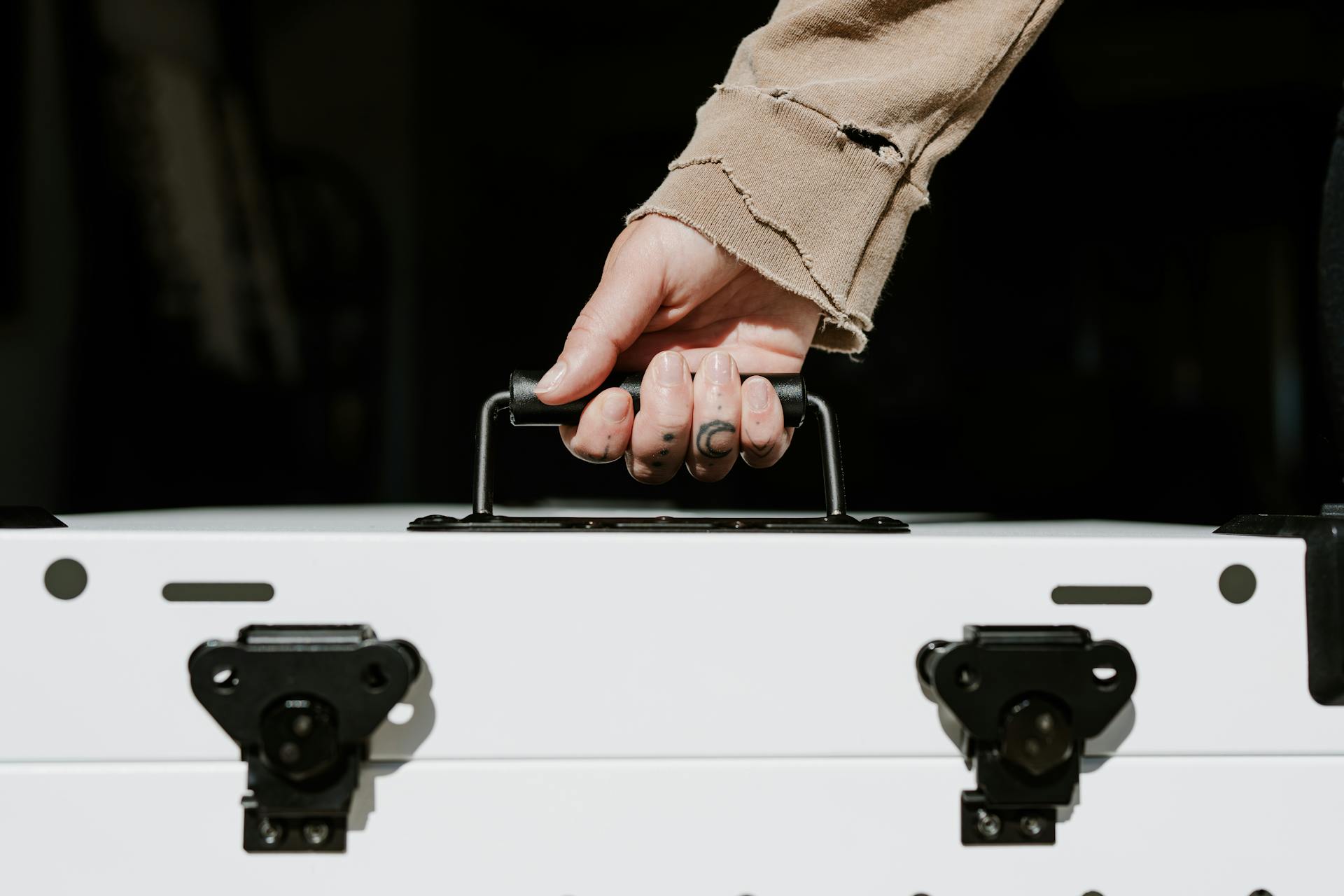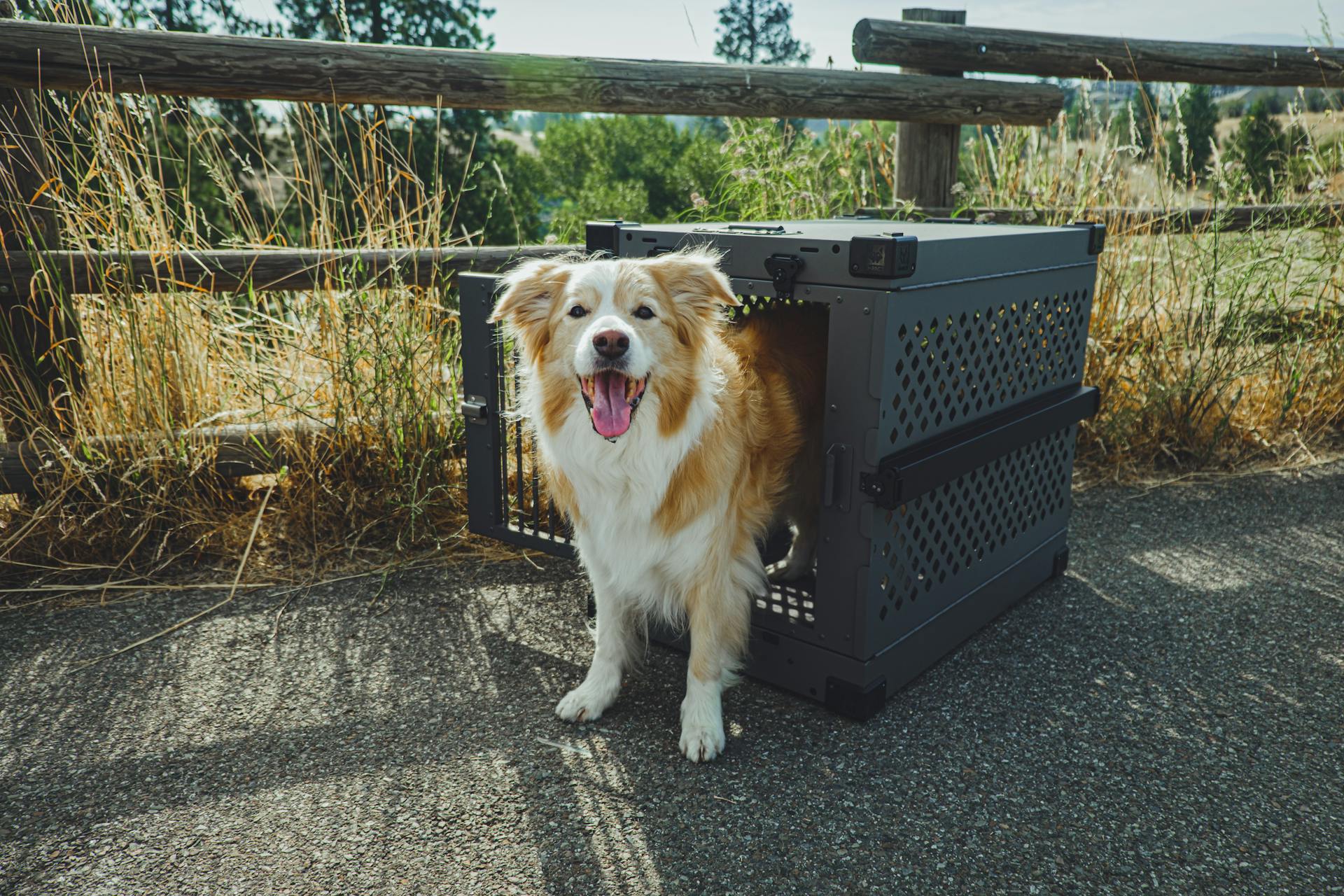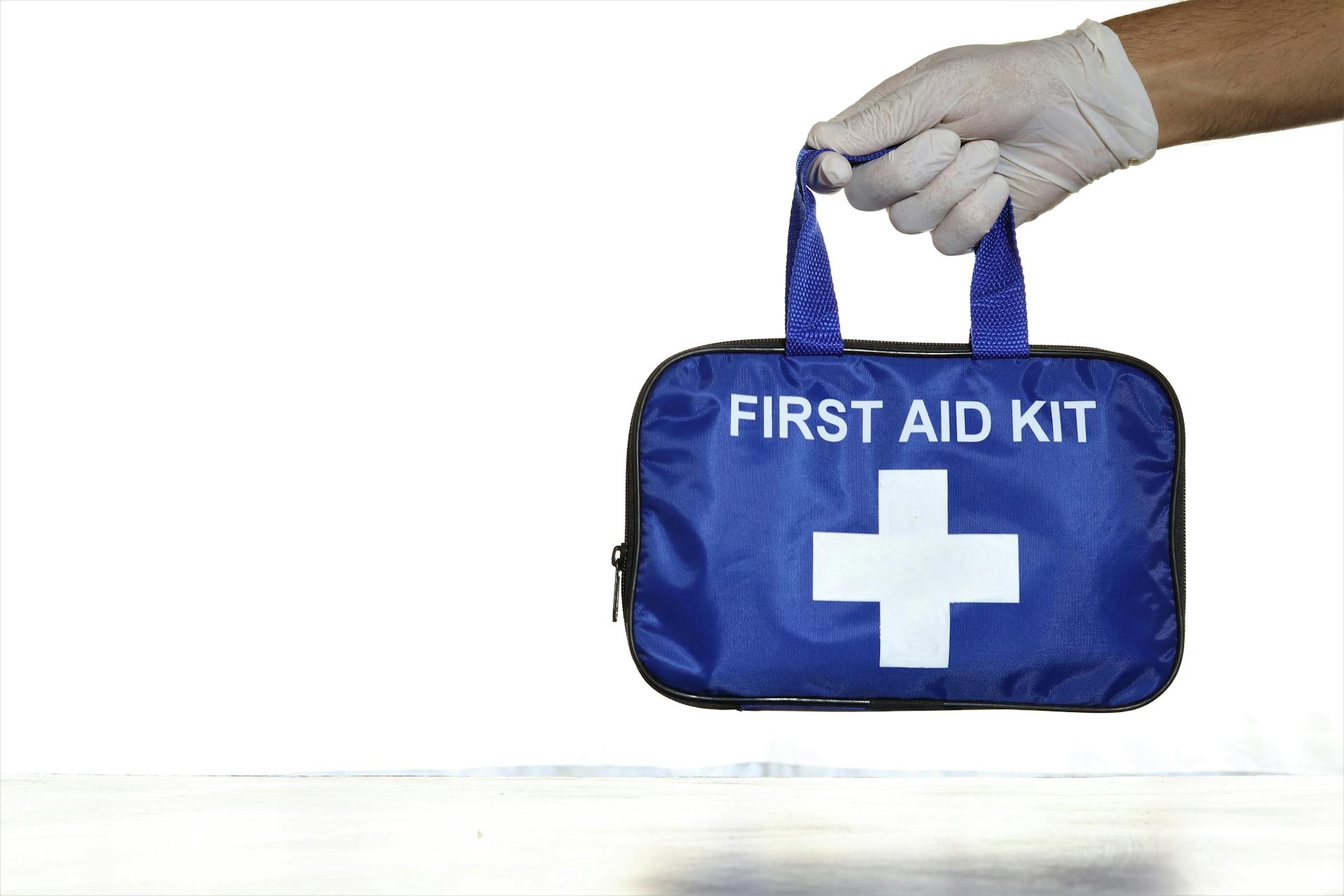
Crate training is a great way to help your pet feel safe and secure, but it's not just about tossing a crate in a corner and expecting everything to work out. Crate training aids can make a big difference in your pet's happiness and health.
Using a crate with adequate ventilation is crucial, as it can help prevent respiratory problems. A well-ventilated crate can also reduce the risk of your pet getting overheated.
Crate training can be especially helpful for pets with separation anxiety, as it provides them with a sense of security and comfort. This can be especially true for pets that are prone to destructive behavior when left alone.
A crate with a comfortable bed or mat can make all the difference in your pet's crate training experience.
If this caught your attention, see: Pet Ecollar
What You Need to Know
Crate training is a process that involves gently acclimating your puppy to stay in the crate during specific times.
Persistence is key to successful crate training. Following a consistent routine and providing positive reinforcement will teach your dog to associate the crate with rewards and good feelings.
You should introduce your dog to the crate gradually, starting with letting them look inside and then placing their favorite toy or treat in the crate to encourage entry. As soon as they go inside, praise them.
It's essential to wait until your dog is at ease entering and exiting the crate before closing the door. Closing the door too soon can lead to unwanted behavior like barking or whining.
Ignoring unwanted behavior and waiting for your dog to stop before unlatching the door is crucial in crate training. By doing so, you'll teach your dog that only good behavior releases them from the crate.
Some dogs take longer than others to acclimate to a crate, so it's vital to remain patient and not use the crate as a form of punishment. This will only hinder training efforts and create a negative association with the crate.
Crate training can be challenging, but with persistence and positive reinforcement, your dog will learn to love their crate and use it as a safe space to relax.
Recommended read: Is Crate Training Good for Puppies
Benefits and Tips
Crate training aids are designed to make the process easier and more effective. One of the most significant benefits of crate training is assisting in dog potty training, as dogs instinctively won't soil their beds.
Providing your dog with their own special space can help curb overexcitement and reduce destructive behavior. A comfortable dog is less likely to engage in destructive behavior.
Consistency is key when it comes to crate training. You cannot make your pup love his crate with tools alone, and patience is essential as it may take time for your pet to adapt to using a crate.
Positive reinforcement is crucial in crate training. Associate the crate with pleasant experiences, such as crate training games, fun activities, treats, or restful sleep.
Here are some benefits of crate training:
- Crates Provide a Comforting Space for Your Dog
- Airplane and Vehicle Travel is Safer with a Crate
- Crates Keep your Dogs Safe During Emergencies
- Crates are a Powerful Tool for House Training
- Crates Protect Your Pup and Home
To crate train a dog, persistence goes a long way. Follow these steps and your dog will be using their crate to relax or rest their eyes in no time!
Choosing the Right Crate
Choosing the right crate is crucial for your dog's comfort and safety. Measure your dog's length from nose to tail and add two to four inches to determine the ideal crate size.
Your dog should be able to stand, stretch, turn around, and lie down in the crate without feeling cramped. Make sure your dog's weight doesn't exceed the crate's weight limit.
Wire and plastic crates are good options for crate training, as they are sturdy and easy to clean. Wire crates allow for high airflow and visibility, while plastic crates are lightweight and can be used as carriers.
To choose the right location for your crate, consider placing it on the same floor as the potty door and on an easy-to-clean floor. This will make it easier to get your puppy to the potty spot and clean up accidents quickly.
Here's a quick rundown of crate size options:
Choosing the Right Crate for Your Dog
To determine the right crate size for your dog, measure their length from nose to tail and add two to four inches. This will give them enough room to stand, stretch, turn around, and lie down comfortably.
A good rule of thumb is to choose a crate that allows your dog to stand up without their head touching the top. If your dog is still growing, consider purchasing an adult-sized crate with divider panels to adjust the size.
When it comes to crate material, wire or plastic crates are ideal for crate training. Wire crates offer high airflow and visibility, while plastic crates are lightweight and can be used as carriers.
Here are some key factors to consider when choosing a crate:
- Size: Measure your dog's length and add two to four inches to ensure a comfortable fit.
- Material: Wire or plastic crates are best for crate training.
- Weight limit: Make sure your dog's weight doesn't exceed the crate's weight limit.
- Dividers: Consider purchasing a crate with divider panels to adjust the size as your dog grows.
Remember, a sturdy crate is essential for your dog's safety and comfort.
Snuggle Puppy and The Dap
The Snuggle Puppy and The DAP are two fantastic tools to help your puppy feel more comfortable in their crate. The Snuggle Puppy is a soft, plush stuffed animal with a "real-feel" mechanical heartbeat that simulates the comforting intimacy and warmth that puppies receive from their littermates and moms.
For another approach, see: Prong Collar Puppy
It's a great idea to use it from the first day you get your puppy, and you can even rub it on the mama dog or have her sit with it for a while before bringing it home. This will help your puppy associate the Snuggle Puppy with good feelings and calmness.
The Snuggle Puppy can be left in the crate or taken out and cuddled outside, and it's especially helpful during naps and sleeping. If your puppy starts to chew on it, you can remove it from the crate and place it on top with the heartbeat feature going to prevent chewing hazards.
The DAP, or Dog Appeasing Pheromone, is a plug-in diffuser that can help reduce separation-induced anxiety, fear in puppies in a new environment, and anxiety and stress during transportation. It's available in three forms: collar, spray, or plug-in, but the plug-in is the best option for use in the crate.
The DAP takes the edge off but won't sedate your dog, and it works by reducing the anxiety-producing hormones already in an anxious pup's system. It takes a period of exposure, often as little as 20 minutes, for the pheromones to reach a pup's brain and have an effect.
Intriguing read: Will Crate Training Help Separation Anxiety
Here's a quick rundown of the three forms of the DAP:
By using the Snuggle Puppy and the DAP, you can help your puppy feel more comfortable and calm in their crate, which is an essential part of crate training.
Discover more: Bark Collar on a Puppy
Training and Tools
Crate training a dog can be challenging, but persistence is key. Introduce your dog to the crate by setting it up and letting them look inside, then place their favorite toy or treat in the crate to encourage them to enter.
Positive reinforcement is essential in crate training. As soon as your dog enters the crate, offer plenty of praise to teach them to associate the crate with rewards and good feelings.
It's essential to wait until your dog is at ease entering and exiting the crate before closing the door. Start with short periods, only leaving the door shut for a minute or so, and ignore any unwanted behavior.
Some dogs take longer than others to acclimate to a crate, and it's crucial to remain patient and not use the crate as a form of punishment. This will only hinder training efforts.
To make crate training more enjoyable for your dog, try using crate training tools such as toys, treats, and comfortable bedding. These can help make the crate a welcoming space for your pup.
Leaving your dog in the crate can be difficult, but it's an essential part of the training process. Start by leaving the room for short periods, waiting until the fussing stops before returning, and gradually increase the time you're away.
Troubleshooting and Misconceptions
Crates can be a lifesaver for both you and your furry friend, but sometimes things don't go as planned. Let's tackle some common issues and misconceptions.
Don't let your dog out of the crate for barking and whining; ignoring them is key. If you think your dog needs to go out, wait for a quiet moment or have them "touch" or sit first, and then open the crate door.
Some dogs love their crate covered, so try a light sheet or blanket over the crate. Others might chew up their crate bed, so switch to a material without stuffing, like a towel or blanket. If necessary, your dog can sleep on the crate floor.
Crates aren't suitable for dogs with separation anxiety, and using the crate as a punishment tool is a no-go. It should be a safe, positive place for your dog to relax.
Here are some troubleshooting tips to keep in mind:
- Re-examine how long you're leaving your dog in the crate; shorter time frames might be needed, especially if your dog is a puppy.
- Try a different texture of blanket or towel; some dogs like to poop or pee on a certain texture of bedding.
- Use a 'safe confinement doggie area' instead of a crate if your dog hasn't been crate trained or if the crate is highly stressful for them.
Troubleshooting Tips
If your dog is barking and whining, ignoring them might be the best approach, but only if you're certain they don't need to go out. Wait for a quiet moment or have them 'touch' or sit first, and then open the crate door.
Some dogs prefer their crate covered, so try using a light sheet or blanket over the crate. This might help them feel more secure.

If your dog chews up their crate bed, it's likely because they don't like the material. Try switching to a towel or blanket without stuffing, or even letting them sleep on the crate floor if necessary.
If your dog poops or pees in their crate, it's probably because they're spending too much time in there. Shorter time frames might be needed, especially if your dog is a puppy. You can also try a different texture of blanket or towel to see if that helps.
In some cases, a crate can be a source of stress for dogs. If your dog hasn't been crate trained or if the crate is highly stressful for them, consider using a 'safe confinement doggie area' like a dog pen or a kitchen blocked off with a gate.
Crates aren't suitable for dogs with signs of separation anxiety. If you suspect your dog has separation anxiety, explore other options for their confinement.
Remember, a crate should be a safe, positive place for your dog. Avoid using it as a punishment tool, as this can create more problems than it solves.
Misconceptions About Crate Training
Crate training is often misunderstood, but it's actually a valuable tool for teaching dogs how to handle stress and feel more confident on their own.
Some people think that crate training is a form of punishment, but this couldn't be further from the truth. Crates are actually a comfort for dogs, providing a safe and secure spot for them to retreat to.
Dogs are natural "den animals" and they enjoy having their own private space where they can relax and de-stress. In fact, many dogs actively seek out spaces where they can unwind and escape from loud or noisy surroundings.
If a dog suffers from extreme anxiety, a secure dog crate can make a big difference by providing a calm and soothing environment away from potential triggers.
Crate training isn't about locking your dog away, it's about teaching them to feel safe and secure in their own space. By following the right steps and being patient, you can help your dog learn to love their crate.
Broaden your view: What Does a Shock Collar Feel like
Frequently Asked Questions
What is the best crate training technique?
Gradually increase crate time and distance with a calm, repetitive routine, starting with short periods and frequent returns. This gentle, phased approach helps dogs adjust to being alone and builds trust in their crate.
What helps crate anxiety?
Gradual introduction and positive associations with the crate can help alleviate crate anxiety in pets. Start by introducing the crate gradually and building a positive relationship to help your pet feel more comfortable and secure.
Sources
- https://www.fourpaws.com/pets-101/potty-time-and-training/crate-training-your-dog
- https://www.maddiesfund.org/crate-training-your-dog-or-puppy.htm
- https://www.diyk9.com/crate-training
- https://www.howtotrainadreamdog.com/crate-training-tools-for-puppies/
- https://www.impactdogcrates.com/blogs/puppy-news/what-is-crate-training-5-tips-for-crate-training-your-dog
Featured Images: pexels.com


